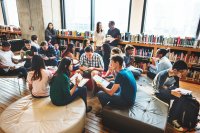Project-Based Learning and the Research Paper
Students take responsibility for their learning and develop solutions for complex problems when their research paper becomes a PBL unit.
Your content has been saved!
Go to My Saved Content.In 11th grade, students in my county are expected to generate a research paper or product. In the past, I stuck to the traditional paper, mostly because doing so was comfortable for me as an English teacher. I can do papers. I can do essays. I can provide feedback and teach revision.
However, last year I took a risk—instead of the traditional paper, I told my students we would be embarking on a project-based learning (PBL) journey. They seemed excited, mostly because they thought they wouldn’t have to write a paper. In the end, they did so much more than that.
Project-Based Learning in High School English
I had my students form groups and then gave each group the task of choosing an issue they were interested in. The project would involve coming up with a viable solution. As a class we brainstormed all kinds of big issues, including school shootings, poverty, LGBT rights, bullying, and homelessness, as well as local issues like the need for more options in school lunches, such as vegan and gluten- and diary-free options.
Next they had to brainstorm possible resources and questions they needed to answer. Therein lies the beauty of PBL: Since I couldn’t anticipate their every need, they had to take responsibility for their own learning, and solve problems as they encountered them.
Mini-Lessons and Formative Assessments
Their first formative assessment developed organically as they realized they would need to email professionals who could answer questions to guide their research. These adults included our school principal and our security team, as well as local government officials. Students reached out to their local delegates and other elected representatives, including the congresswoman for our district.
I gave a mini-lesson on how to write a formal email, and then the students composed their emails. Before they sent the messages, I previewed them, offering feedback and constructive criticism (formative assessment), and students made revisions.
By the next class period, my students had one of two versions of the same problem: Their recipients had responded or they hadn’t, but either way my students didn’t know what to do.
I gave a mini-lesson on how to send a follow-up email when someone doesn’t respond and on how to move forward when they do. They wrote follow-up emails, and again I previewed these. As we awaited responses, several groups asked if they could poll the staff or their peers about school lunch choices, improving school security, and expanding the school parking lot. This exercise could benefit all groups, so we decided to make it the next task.
I showed them how to create an online survey using Office 365. Their surveys had to contain at least two graphics and 10 good questions (open ended, multiple choice, or order of importance).
Meanwhile, students continued getting responses from their email recipients and needed to set up interviews with those people. How to write good interview questions became the next mini-lesson. My students were largely unaware of how to interview someone and didn’t realize that the questions they prepared were critical in gaining the evidence they needed to support their proposals.
For example, a group who wanted to expand the school parking lot went from asking broad questions like, “Do you think we need a larger parking lot?” to very specific ones like, “How many accidents have occurred in the parking lot since the school opened?” Most of the interviews were conducted over the phone, but some were in person—one group, with permission from their parents, interviewed members of a local homeless camp.
Students also had to find at least three solid sources and take notes to be embedded in their final product, with correct citations. They found statistics and data to support their proposals, and made sure to address counterarguments.
The Final Products
I gave my students options for their final products. All of them had to contain their survey results, research, and emails and interviews in one form or another. They came up with ideas like a public service announcement, a formal proposal, a bill, a documentary, a photo essay, or a piece of music or art.
I created rubrics and exemplars so students would know what I was expecting. I didn’t want to be too controlling, but I wanted high-quality products. They shared their final products with a variety of authentic audiences, including their congresswoman, our principal, a county supervisor, and our security team.
I gave each group one summative grade, but in the future I plan to split the grade: 70 percent of each student’s grade will be for their group’s work, and 30 percent will be an individual grade based on my observations, students’ self-reflections, and peer reflections.
As students shared their projects and we reflected on the process together, a few things became clear to me. First, I’ll never teach the research paper any other way because the PBL model we used helped develop real-world problem solvers, thinkers, and doers instead of rule followers. I learned that to encourage students to step out of their comfort zones, I too had to step out of mine, but beautiful, authentic learning happens when we create the right conditions for it.
